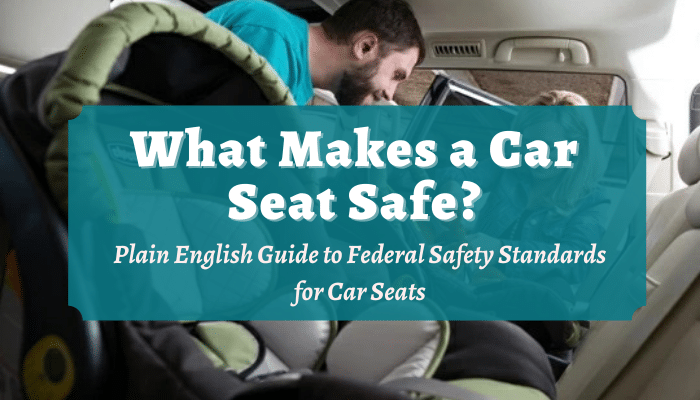
The National Highway Traffic Safety Administration and American Academy of Pediatrics are constantly working toward new ways to enhance your child's safety while they're in a car seat.
With the ever-changing safety regulations, knowing if your car seat meets US standards can be confusing and challenging, especially if you're not sure what to look for.
In this article we explain what makes a car seat safe according to five of the major indicators that a car seat must have to meet US safety standards.
How Do I Know If My Car Seat Meets U.S. Standards?
1. Labeling
According to Consumer Reports, the labeling on a car seat is one of the best ways to determine if it’s compliant with US safety standards. These labels provide key information that lets you know that the car seat adheres to the federal safety standards and that it’s certified for use in a vehicle (or aircraft). When worded a certain way, the label indicates that the car seat has been tested to comply with the Federal Motor Vehicle Safety Standard 213.
Labels on the car seat should also give you basic instructions for using and installing the car seat, provide the manufacturer’s name and contact information, and give you the Date of Manufacture (DOM).
Jennifer Stockburger, the director of operations at the Consumer Reports Auto Test Center in Connecticut, says, “ If your car seat does not display these bits of information, then it doesn’t comply with federal safety standards.”
Stockburger goes on to stress the importance of how the labels look because if you’re buying a used car seat from someone you know or a third party, the labels could be counterfeit. For this reason, if you do buy a used car seat, I advise that you buy it from someone you know and trust.
2. LATCH
LATCH stands for Lower Anchors and Tethers for Children. It’s one of the biggest improvements for car seat safety, and it serves as a safer and easier to use alternative for seatbelt installation. This is not to say that installing a car seat with a seatbelt is unsafe. If you install a car seat with a seatbelt properly, it should be just as safe to use as it would be if you had installed it using LATCH.
LATCH pretty much makes it easier to get a proper installation. If your car seat comes with both the LATCH and seatbelt installation options, it’s recommended that you use the LATCH system to install your car seat. At the end of the day, you don’t want to take the chance of installing your car sear incorrectly with a seatbelt unless you know what you’re doing.
3. Extended Rear-facing Weight Limit
Extensive research has been done to determine how safe it is to keep your child seated in the rear-facing position longer. In 2018, the American Academy of Pediatrics revised their policy statement regarding child passenger safety by including new recommendations and practices that parents should implement to ensure their child’s safety. The first revision reads, “All infants and toddlers should ride in the rear-facing position for as long as possible until they reach the highest weight or height allowed by the seat’s manufacturer.”
Benjamin Hoffman, M.D., lead author of the new policy statement and chair of the AAP Council on Injury, Violence and Poison Prevention, noted how over the past ten years and despite safety innovations, one of the leading causes of death for children was car crashes.
To adhere to the AAP’s recommendations, most manufacturers today engineer car seats with an extended rear-facing weight limit that ranges anywhere from 40 to 50 pounds. It’s safe to assume that car seats with a lower rear-facing weight limit are out of date with the updated safety standards.
4. Safety Ratings
Safety ratings are a great way to figure out if your car seat is up to par with US safety standards. The National Highway Traffic Safety Administration (NHTSA) is a highly credible organization that rates almost every car seat from a wide array of manufacturers. These ratings are based on the following:
Together, these ratings basically sum up if a car seat is safe and meets US standards. The NHTSA even goes as far as to rate how easy it is for parents to read and understand the labels and product manual of a car seat. Also, with these ratings, you’ll get a better idea of if the installation features are secure and easy to use, and you’ll know if the harness system is secure or needs work.
So, if your car seat is listed by the NHTSA, that’s a good sign that it's been thoroughly evaluated by an accredited source.
5. Harness System
It’s highly recommended that when it’s time, parents use a car seat with a 5-point harness.
A 5-point harness has five straps - two over the shoulders, two on each side of your child’s pelvis, and one between the legs. Some car seats are equipped with a 3-point harness that only has straps going over the shoulders and up between your child’s legs. 3-point harnesses have pretty much become outdated with the innovation of the 5-point harness. The reason being is because a lot of people and organizations believe that 5-point harnesses are safer, which is arguably true.
Here are a few reasons why:
For these reasons, having a car seat with a 5-point harness is a good indicator that it’s safe and meets US standards.
What makes a car seat safe? By Bob Wall
Conclusion
Finding a car seat that's safe by US standards can be challenging, but it can be made easy when you know what safety indicators to look for in a car seat. Remember that labeling is important and that car seats that are up to date with US safety regulations will have everything covered in this article.
If you have any doubts about a car seat's safety, DO NOT USE IT! It's not worth the risk. Instead, you can file a non-vehicle complaint here. You can also call the NHTSA Safety Hotline at 888-327-4236.

Growing up I was a carefree male going about life like there was no tomorrow. Naturally, I ‘grew’ up, settled down and started a family.

Going from an independent carefree male to a family man was somewhat of a U-turn and required a lot of learning. Luckily for me, my wife works in education and has always been the shining light always ahead of me on all factors kids related.
Initially, my wife didn’t have a driving license (luckily this has now changed and it does make life easier), and all things car related were my task. Child locks were the obvious starting point which lead me down a rabbit hole.
So far we have personally tested dozens of convertible car seats and have owned five despite neither of our kids having reached the age of 5! Simply put, a car seat can be great on paper, work great on trying out but can fail on you in real life.
This is why I have put together this website – to help inform and educate you!
Of course, as I mentioned above, at the end of the day your experience will be the best test so I’d love to hear your experiences and feedback in the comments.
To contact me personally, please do so through my contact page.
I look forward to hearing from you!
Peter
P.S. If you click a link on my site and end up buying a car seat on Amazon, I’ll get paid a small commission (or as the Amazon lawyers put it: “As an Amazon Associate I earn from qualifying purchases”)
Leave a Reply